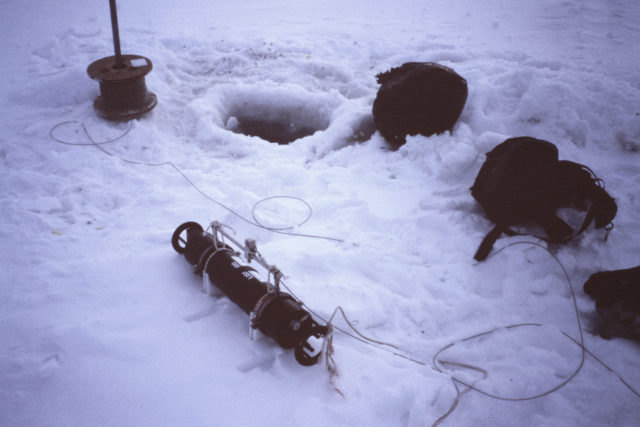In the remote, frigid and – often – ice-covered waters of the Arctic Ocean and the Southern Ocean, complex interactions between physical, chemical, and biological processes shape global climate and marine ecosystems. Scientists use a comprehensive range of sensors, platforms, vehicles and methodologies to study these interactions. This includes Sequoia instruments such as the LISST-100X/LISST-200X, LISST-VSF, LISST-Holo2, LISST-Deep and more.
Why Particle Size and Optical Measurements Matter in Polar Waters
In polar marine systems, particles play a central role in biogeochemical cycling, light attenuation, and ecosystem structure. From glacial flour and sea ice algae to marine snow and resuspended sediments, the size and composition of particles influence:
- Primary productivity through light availability and nutrient fluxes.
- Carbon export via aggregation and sinking of organic matter.
- Optical properties relevant to remote sensing and under-ice navigation.
- Sea Ice formation through frazil ice formation
Sequoia’s LISST and Hyper instruments delivers the high-resolution, in situ measurements needed to accurately characterize these processes.
Challenges of Polar Deployment
Deploying any instrument in ice-covered waters presents unique logistical and environmental challenges, for example access through the sea-ice. This typically requires ice coring or the use of ice-tethered profilers and remotely operated vehicles (ROVs). The picture shows the LISST-100 (discontinued in 1999), ready for deployment through a hole in 2 m sea ice on Baffin Island in 2000 – it performed flawlessly despite the chilly circumstances.
Case Studies and Applications
Studies have used LISSTs in polar settings (or very cold laboratories!) to:
- Relate optical backscattering to particle size distribution. Reynolds et al. (2016) found no clear relationship between the spectral slope of the particulate backscattering coefficient, bbp, and the slope of the particle size distribution measured with LISSTs and Coulter Counter; contrasting with theoretical models: The polar regions may require unique model developments.
- Investigate if oil spill dispersants are effective in cold water. Until 2008 the notion was that frigid waters of polar regions would render dispersants ineffective in oil spill situations. However, Mullin et al. (2008) using a LISST-100 in the Ohmsett test facility showed this to be a fallacy: Dispersants are at least 90% effective in cold waters.
- Suggest that polar fronts, such as the Barents Sea Polar Front, can function as accumulative structures where particles ‘pile up’ or aggregate at certain times of the year (Renaud et al. 2024), suggesting that fronts can be important in controlling particle dynamics.
- Sandven et al (2020), used a LISST-VSF and LISST-200X to study the VSF in extremely clear waters at the North Pole, as well as in turbid glacial meltwaters. They found variations in the VSF phase function, suggesting that one cannot assume a constant ratio between bb and b, for example, in the polar regions.
- Frazil ice formation in the lab was measured by Lahncihi (2019) using a LISST-Holo.
Looking Ahead
Polar research will intensify in response to climate change. Sequoia’s instruments will continue to be indispensable for advancing our understanding of particle-mediated processes and their importance for the physical, chemical, and biological processes impacting climate change.
Get in touch with us to discuss how Sequoia’s LISST and Hyper instruments can advance your polar research!
